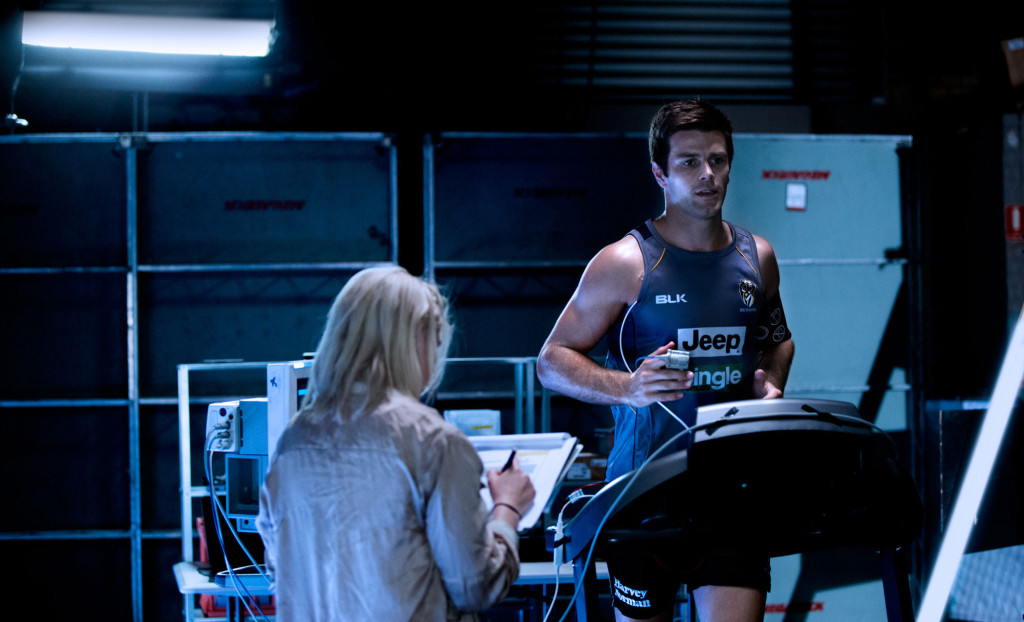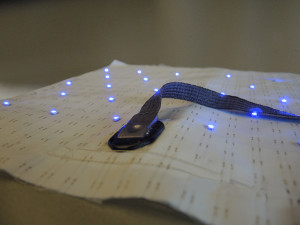
The Alert Shirt by Wearable Experiments (WE:EX) is a fan jersey that allows the wearer to feel what the players feel live as it happens during a game. Photo: WE:EX.
Are you ready for the next generation of wearable technology and the impact it will have on your business? Is it something you’ve even considered?
Just seven years ago, when Apple launched the iPhone, few people would have foreseen the massive impact of smartphones on the way we live today. According to Pew Research from January 2014, almost 58 percent of American adults owned a smartphone and 29 percent described it as “something they can’t imagine living without.” This was such a disruptive technology that it impacted industries as diverse as entertainment, news distribution, photography and travel. Who’d have thought?
Smartphones have changed the way we interact with technology. With over a million apps available, communicating via calls and texts is no longer even the primary function of our smartphones. Instead we use them for a range of ways to make our lives easier, better, healthier or just more fun through social networking, gaming, entertainment, health/fitness tracking and productivity apps.
Wearing and carrying
Now that we’ve grown comfortable with carrying technology, we’re starting to see new benefits in wearing it. Beecham Research currently forecasts that the “wearables” market is on course to achieve global sales of around $3 billion by 2018, but predicts that “with a true multi-disciplinary approach and greater collaboration,” this could increase to $9.3 billion. Last year Credit Suisse projected wearables achieving up to $50 billion in the same period, while most recently Juniper Research put their pin in the board at around $19 billion. The forecast figures may be inconsistent, but the anticipation of substantial and rapid growth is clear.
So far, health and fitness have been two of the primary market drivers behind this growth, with activity tracking devices such as the Fitbit or Misfit Shine and mobile apps such as MyFitnessPal and RunKeeper (with tens of millions of registered users) reflecting new patterns of consumer behaviour driven and enabled by wearable technology. Millions of people are now using these technologies to monitor everything from their eating habits and activity levels to their weight and sleeping patterns, in a bid to better understand and influence their own health and fitness levels.
With the introduction of Obamacare, U.S. employers are eager to cut health care costs and have new ways to offer employees incentives for healthy behavior mean that many are looking to wearable health and fitness monitoring devices to help achieve this. Indeed, the recent moves by some of the key technology players to introduce health data platforms (Google Fit, Apple HealthKit and Samsung Sami) is itself an indication of how important wearable health and fitness monitoring is set to become.
Although e-textile wearables have been around for over a decade, the market has not yet reached the mass-scale tipping point and remains a long way behind the adoption rates of other wearables. However, with annual apparel volumes estimated at over 50 billion units and with the acceptance of body-worn technology increasing, e-textiles are now being viewed by the technology industry as a key opportunity for future growth.
The fact that the range and performance of textile technologies, such as conductive or responsive yarns and fabrics, are constantly improving is enabling more commercial developments and creating better products. However, some of the biggest influences on the pace of recent developments have actually been a result of the convergence of several trends and drivers from the mobile computing and communications sectors.
Smarter and smaller

Ever-shrinking electronic components have been a key enabler of the current generation of wearable technologies. Smarter and smaller microprocessors are also becoming more power-efficient with every release, so even data-hungry devices like activity trackers, which need to be “always-on” to be effective, can use much smaller batteries than smartphones.
The introduction of Bluetooth Low Energy (BLE) has been one of the most important breakthroughs, allowing wearable devices to connect to smartphones as “hub” devices and transmit/receive high volumes of data over higher ranges (up to 100 meters) with a much lower amount of power than any previous versions. This technology alone has enabled many devices to use smaller batteries, making the devices smaller and easier to wear, but more critically, it has cut the need for frequent re-charging from hours or days to weeks or even months.
BLE has another benefit which is helping to establish it’s position as the de facto wireless transmission technology in wearables: an inherent ability to connect and broadcast to other BLE devices (known as iBeacon technology), already extensively adopted by smartphone and smart devices makers. This creates low power “mesh networks” which can connect multiple devices and which improves the accuracy of both indoor and outdoor location services from meters and feet with GPS and Wi-Fi signals, to just a few inches.
The networks
The growing availability of 4G and super-fast broadband services has provided another essential platform for growth. The ability to remain connected all the time and everywhere is essential to the effectiveness of most wearables. Right now, 5G services are being developed that will introduce a further step-change in the speed and volume of data that these connections will be able to handle. The rollout of 5G services is anticipated to happen in the next three to five years, to coincide not only with the spread of wearable devices, but the simultaneous growth of other smart devices in our cars, homes and workplaces as the “Internet of things” (IoT) expands.
While it’s clear that these developments have helped to fuel the current explosion of wearable developments, what’s not so clear is why, despite over a decade of research and commercial developments and improvements in e-textiles, smart garments are not yet achieving mass market adoption. With all this impetus and a growing consumer appetite, what are the barriers currently holding back e-textiles from transitioning to mainstream apparel?
The e-textiles holdup
To date, the main drivers of e-textile-based wearables have been health care (with products often developed by electronic device suppliers with little or no experience with clothing), sportswear (relatively sophisticated clothing brands with little or no experience in the electronics industry) and the military (a combination of the two). So far, however, there have been relatively few e-textile commercial successes and much of the sector remains niche based and relatively low volume. Some of this is due to the lack of joined-up thinking and development in the sector so far.
Production and design issues common across the industry, such as creating simple and reliable connectors for integrating electronic hardware or creating durable flexible-component technologies, have often been resolved with proprietary solutions developed by the individual. Early e-textile inventors and universities have amassed a mountain of patents in these areas, which has created a considerable barrier to entry for newcomers and equally has frustrated cost-reduction and product-improvement efforts by the existing players.
The apparel manufacturing industry has historically had few barriers to entry with little capital investment and a high level of labor, along with skills that were relatively quick and easy to develop. Integrating electronics, however, requires more than just learning how to handle a new type of trim. For most, it means investing in new equipment, very different skills and industry standards and finding new suppliers from a sector of which they have little or no knowledge.
With no promises or certainty of forthcoming volume orders and clients ranging from new startups to electronic device makers, it’s not entirely surprising that very few apparel suppliers have taken the risk of figuring out how to reliably supply these new products or invest in doing so.
The lack of bulk manufacturing capability and capacity is, however, creating one of the biggest barriers to growth. Some enterprising innovators have endeavored to bridge this gap by creating ways to make it easy for brands and less risky for suppliers to work with a range of electronic components. Fibretronic Ltd., Hong Kong, and German company Interactive Wear AG have introduced reliable and easy-to-integrate OEM sub-assembled modules for applications such as lighting, heating and music player/smartphone controls. Recently, Ohmatex, based in Denmark, introduced a new type of fabric connector that can be adapted, fabricated and attached at the point of use with some relatively low-cost equipment. Creating useful bridging technologies like these has enabled some less tech-savvy suppliers to enter the sector, albeit in a limited way, but it hasn’t been enough to develop wide-scale, e-textile production capacity.
Market examples
Conductive yarns and fabrics continue to improve and the ranges expand, creating better, more durable and reliable building blocks for new products. Textile electrodes are now able to collect clinical grade physiological data comparable to gel electrodes, but can be integrated into clothing and worn comfortably all the time, adding critical core health data to monitoring in both sports and healthcare settings.
Many of the same materials can be used to sense other signals, too, and new uses are beginning to emerge. EMG (electromyography) sensors, for example, can detect muscle fatigue and are being used by brands like Myontec and Athos, to offer sophisticated monitoring products for sports training and rehabilitation.
Beyond sportswear applications, EMG sensors can also create gesture controls, and it isn’t difficult to imagine lots of possibilities for garment-based gesture control in areas as diverse as prosthetics, security or mobile payment systems.
In the fashion and entertainment sectors, the focus has mostly been on connecting people through clothing-based wearable technology. U.K.-based CuteCircuit has pioneered various technologies to achieve this, from the hug shirt (using heating) to the twitter dress and T-shirt OS (incorporating micro-LED arrays to create wearable displays).
In Australia, Wearable Experiments (WE:EX) has focused on integrating haptic feedback components in their Fundawear and Alert Shirt smart garments, using “touch” sensations to connect loved ones or to allow fans the chance to share the on-pitch experience of their favorite football players.
Powering up
Power remains a challenge and will be for some time yet, despite improvements in power-management by component technologies. For many, energy harvesting sounds like the perfect solution, but current technologies are still a long way from delivering the power density required by the many devices we are carrying and wearing.
A key goal for wearable suppliers is making the technology “invisible” for the wearer. Integrating it comfortably into clothing can achieve part of this, but equally important is reducing the need for frequent charging. Integrating induction coils for wireless charging is an interesting option to encourage take-up of e-textile wearables, allowing clothing to be charged simply by hanging it in the wardrobe, or by the fabric in your seats at home, work or on your commute. In this way and others, e-textiles and wearables could easily impact more traditional textile markets too. Like smartphone disruption, the potential implications of these new technologies on related industries aren’t always apparent until an innovative app developer connects the dots.
As wearable and e-textile technologies continue to evolve, devices and smart garments will connect directly to the cloud and each other without the need for smartphone tethering. The integration of electronic components and power will become even less visible as they become part of the fabric building blocks (power-generating yarns and micro-component containing yarns are already in development), making future integration of technology truly invisible.
Business success
Opportunities for growth are clear and the enabling technologies are falling into place, but to make the transition from niche products to mass markets, one of the most important steps for those looking for e-textile success is in knowing what approach to take.
To become successful in e-textiles involves working in new, unfamiliar areas: electronics, software and even new ways of selling. Bringing textile, clothing, electronics hardware and software expertise under one roof is one strategy that has proved successful, but also represents a high-risk and high-cost option, especially if you select the wrong talent. It also often tackles only the creative solution–not the supply chain problem. Hence, many successful start-ups still struggle to grow because of the lack of manufacturing support when they are ready to transition from their in-house or local small-scale production facilities.
The successful players in the smartphone market have actually been the companies who didn’t try to do it all themselves, but who collaborated with the best suppliers and partners to create well-designed, novel solutions and to boost their sales reach. The widespread adoption of smartphones, for example, owes as much to the millions of novel uses imagined by the App Store developers as it does to the impressive technology and design of the products themselves.
Wearable success requires similar business “ecosystems” – offering open (but not always unlimited) access for app developers and makers of other smart devices (including other wearables) to encourage mass connections and uses. Open APIs (application programming interfaces) and SDKs (software development kits) can help to grow the smart garment business via new applications and new user groups and by making the products easier for consumers to integrate with their existing smart devices as the Internet of Things expands.
Products which connect easily and seamlessly to other useful devices, combining to make users’ lives better, easier, healthier or more fun, are more likely to be successful than those which adopt proprietary or closed systems and offer limited uses. Those requiring their own chargers, connectors and cloud services may similarly struggle to gain mass acceptance.
The textile industry picture

The textile and clothing industry is much more fragmented than the consumer electronics industry, with few large or dominant suppliers. In this environment, the benefits of collaboration are even more beneficial, offering potential for fast access to expertise and equipment, shared risks and development costs and quicker commercialization time scales. In particular, collaboration of shared interest groups, including competing brands, to develop common solutions to industry-wide problems—as well as to create and agree on industry standards—could have a substantial impact in fast-tracking mass scale adoption and benefit the whole industry.
Finding and developing collaborative ecosystems and learning to work with such divergent industrial partners is challenging, but the proliferation of wearable technology and smart fabric conferences, events and online communities are all making it easier to locate and understand new partners and what they can offer.
Like smartphones, e-textiles represent another way for us to change the way people interact with technology, and indications are that despite limited success to date, they are likely to be a key platform for future wearables. In the next seven years, it is possible that wearable technology integrated into clothing will become just as indispensable to us as smartphones are now and we will simply expect our everyday clothing will monitor and track our activities, health and location, be responsive to our actions and environments, and able to connect us seamlessly with a much broader ecosystem of smart devices.
For those who haven’t yet considered the potential impact of e-textiles, perhaps now would be a good time to join the conversation.
 TEXTILES.ORG
TEXTILES.ORG


